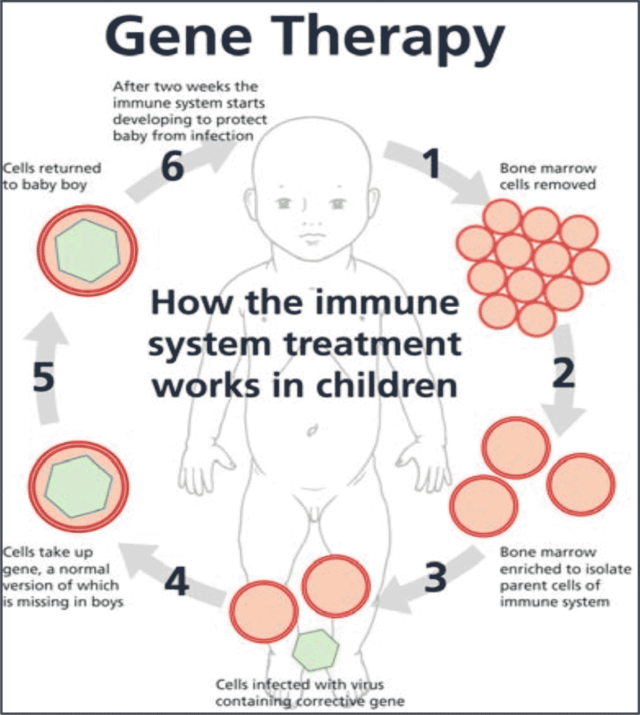Gene therapy is a hot topic today. It offers the potential of a whole new series of advanced treatments for a large number of medical conditions and cures for many diseases and there have been some successes in some areas, and some equally disappointing failures in others. The purpose of this leaflet is to outline how X-linked Lymphoproliferative Syndrome (XLP) sufferers could potentially benefit from this emerging science and to outline how this could work specifically for XLP1 and XIAP.
XLP1 is a rare, often fatal disease that affects only boys and has profound damaging effects on the immune system. It is caused by an abnormal immune response to the Epstein-Barr (EBV) virus. In normal people EBV causes ‘glandular fever’ but in XLP1, EBV infection may cause a number of different problems including overwhelming glandular fever, B cell lymphoma or poor immune function. The gene defective in XLP1 has been identified as SAP, a gene required for the correct function and growth of specific cells within the immune system. The only cure today for XLP is bone marrow (also known as stem cell) transplantation. If a well matched donor is found, the chances of success are good but patients still undergo intensive chemotherapy and suffer from side effects of the transplant procedure. In boys who cannot find a good donor or who are very unwell coming into transplant, the chances of success are less good. Thus there is a need to develop alternative, safer ways of treating the disease. With the identification of SAP as the gene, there is the possibility to introduce a correct copy of the SAP gene into the patients own cells; a process termed ‘gene therapy’. The past decade have seen the first successes for gene therapy in curing certain immune deficiencies and work is well underway on gene therapy for XLP1.
XIAP is very similar to XLP1 but where the defective gene is BIRC4. Initially XIAP affected boys who went through a BMT had low survival rates; but this has improved dramatically during the last few years. Working through options with your medical team (in effect on a case-by-case basis) will help determine if a BMT is advisable. Work has recently commenced on laying the foundations for having an approved gene therapy for XIAP.

Gene therapy aims to transfer a healthy copy of the affected gene into the cells of a patient for therapeutic effect. For conditions such as XLP where the abnormalities are in the immune system, the gene needs to be targeted to bone marrow cells which will eventually grow into immune cells. A number of other similar conditions have now been successfully treated using this technique. First bone marrow is extracted from the patient and then bone marrow (HSCs) stem cells are selected and purified. These cells are then cultured with a virus/vector that carries the corrective gene, in the case of XLP1; the SAP gene. After a few days the gene will be integrated into DNA of the bone marrow cells. These gene modified cells will be returned to the patient where over the next few months they grow into a functional immune system.
Today the only possible cure treatment for XLP1 is a bone marrow transplant (BMT also known as a Stem cell transplant), which replaces the faulty immune system. The table below outlines the main advantages of gene therapy over a bone marrow transplant.
Gene Therapy |
Bone Marrow Transplant |
|---|---|
| Available to all | Available to only 70% (finding donors) |
| Repairs existing immune system | Replaces existing immune system |
| Limited risk of GVHD (Graft vs. Host Disease) | High risk of GVHD |
| Keep existing immunity | Low immunity for 2 years |
| Hospital stay 1 month | Hospital stay 2-3 months |
As an emerging science, gene therapy brings the potential to revolutionise many sectors of medicine including the treatment of XLP. But it is still an emerging science and whilst there have been some spectacular successes with other genetic disorders, there have also been sadly some cases where the therapy has not only failed but contributed to the death of the patient.
But as we state above, there is extensive research work on using this technique for XLP1 and we expect this to be availability shortly. Gene therapy research for XIAP is also at early stages.
Gene therapy offers real hope for XLP affected families who cannot find suitable bone marrow donors and could become the treatment of choice for all XLP boys in the near future. The XLP Research Trust is committed to fund raising to ensure that gene therapy becomes a real possibility.
First published July 2008
Updated November 2023
This fact sheet is designed for educational purposes only and is not intended to serve as medical advice. The information provided here should not be used for diagnosing or treating a health problem or disease. It is not a substitute for professional care.